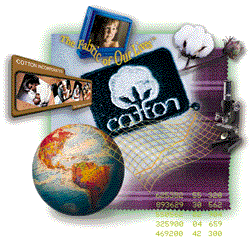
Second Graders Interview Local Farmers
Second grade students found answers for their questions about cotton from family members and local farmers. The answers to these questions might teach you more about cotton. So....in our own words....
How does cotton grow?
You plant seeds into the ground that is ready with water to make it grow. It forms white blooms that turn pink and fall off the stem. A square is formed which turns into a boll. The boll opens up and the cotton is inside the boll.
Haley (information from Mrs. Davis)
What are the stages of cotton?
Seed, plant, boll, harvest
Brenda (researched with Uncle Eddie)
What are boll weevil traps?
The boll weevil traps are yellow and green. The boll weevil traps have a little stick to hold them up. A piece of fly paper and it has a good smell. When the wind blows it spreads the smell around and the boll weevils go to the trap. Then they go into the little hole and go into the trap and are not smart enough to get out.
Tanoah
Is spraying crops a good thing?
Yes, spraying crops is a good thing. We spray so farmers can grow more cotton. Spraying cotton also cleans the fields. They spray from airplanes.
Tyler (information from Dad)
How does a cotton stripper work?
Brushes and bats take the cotton off the stalk. The brushes throw the cotton into the auger. Then the auger dumps cotton into a big auger. The big auger takes it to the middle and then a fan blows it into the basket.
Jennifer (information from Dad)
Blake (information from Dad)
How does a boll buggy work?
A boll buggy takes cotton from the stripper to the module builder. Hydraulic oil extends two cylinders to raise the basket and dump the cotton into the builder.
Corbin (from Dad)
How does the module builder work?
It packs the cotton into a module so that it can be easily hauled to the gin.
Blake (information from Dad)
What are some facts about the Springlake Co-op Gin?
This year the number of bales was 25,145. The number of customers was 162. The cotton was sold to mills to be made into clothing.
Steven (son of gin operator)
What did you learn about your family -owned gin, the Royston Gin?
The number of bales ginned this year was 3,348. The products from cotton include cotton seed, lint which is made into sheets, pants, carpet, shirts, and other products.
The U.S. and China are the world's leading cotton producers.
Jonathan (son of gin owner)
Where do you get information about cotton?
I found information about cotton at www.cotton.org and in The Golden Book Encyclopedia, Book4.
Brittnee (with help from Mom and Dad)
How has farming changed?
It (the price) is the same now as in the "50's"but the prices we pay for tractors and pickups have increased 1,000 %. They started earagating (irrigating) in the "40's". Since then we have nearly depleted our water source. In the "60" years we have very little for our efforts.
Kelcey ( interview with Granddad)
Many of the changes in farming operations are dictated by declining ground water. Planting crops that use less water and more efficient irrigation equipment are two ways to conserve this resource. Planting row crops into cover crops and narrow row spacing to reduce wind and water erosion are two other recent changes.
Corbin (quote from Dad)
Farming has changed dramatically over the years. I believe the implementation of center pivots in the last 10-15 years has had the greatest impact on farming. In addition, with the genetically altered seeds and larger, more sophisticated equipmemt, farming has continued to evolve into a bigger than life industry, rather than just a humble way of making a living.
Ashlee (information provided by Mom)
Is there a future in farming?
Yes as long as people need food to eat and clothes to wear, then there will be a future in farming!
Blake (future farmer, just like Dad)